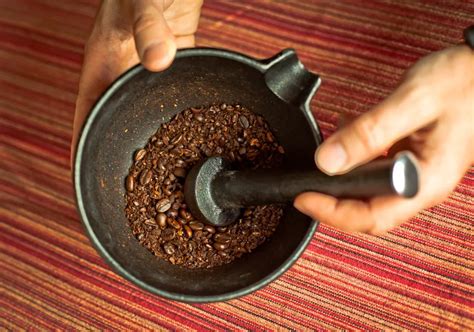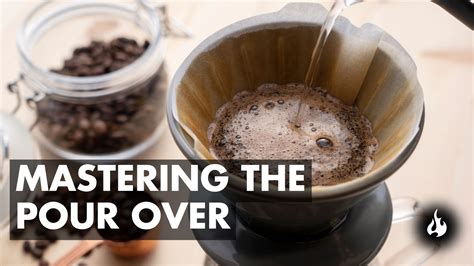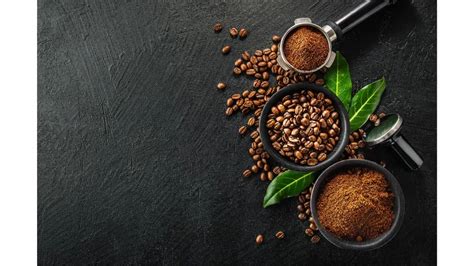There's nothing quite like that first sip of a hot, invigorating beverage that instantly awakens your senses and jumpstarts your day. Whether you're a seasoned coffee connoisseur or an occasional indulger, crafting the perfect cup of morning brew is an art form worth exploring.
In this quest for coffee excellence, we delve into the intricate world of flavor profiles, brewing techniques, and the magical alchemy that transforms humble coffee beans into a rich, aromatic elixir. Join us as we embark on a taste adventure, unlocking the secrets to preparing a morning joe that will elevate your coffee-drinking experience to new heights.
Cultivating the Perfect Beans: The journey to the perfect cup of coffee begins with the selection of high-quality and freshly roasted beans. The choice of beans can mark the difference between an average cup and a transcendent experience. Exploring the plethora of coffee bean varieties from various regions with distinct taste profiles is a delightful endeavor in itself. From the bright, fruity notes of Ethiopian beans to the chocolatey richness of Brazilian ones, the possibilities are endless.
Mastering the Art of Grinding: Once armed with a selection of carefully chosen beans, it is time to navigate the realm of grinding. The grind size is crucial in determining the flavor extraction during brewing, making this step an essential one to perfect. Experimentation becomes your ally here, as you find the ideal grind size to suit your preferred brewing method. From a coarse grind for a French press to a fine grind for an espresso machine, each brew method demands its own unique fineness of grains.
The Art of Grinding: Selecting and Grinding the Ideal Coffee Beans

In the quest for an exceptional cup of coffee, one often overlooks the crucial role that proper grinding plays in the process. The art of grinding involves carefully selecting the right type of coffee beans and subsequently transforming them into the perfect grounds for your morning brew. In this section, we will explore the fundamental principles of choosing and grinding coffee beans to achieve a harmonious balance of aroma, flavor, and texture in every sip.
Before delving into the details of grinding, it's essential to understand that not all coffee beans are created equal. Each variety possesses its distinct characteristics that contribute to the overall taste profile of the final cup. Evaluating the origin, roast level, and processing method of the beans will aid in determining the ideal grind size for your desired brewing method.
When it comes to selecting the perfect grind size, consistency is key. Coarse grounds are suitable for methods such as French press, while medium to fine grounds work best for pour-over or drip brewing. Additionally, the duration of the brewing process also influences the optimal grind size, with shorter extraction times necessitating finer grounds.
Now that you understand the importance of selecting the correct grind size, let us explore the various grinding methods available. From blade grinders to burr grinders, each option delivers a unique result in terms of particle size distribution and consistency. Understanding the pros and cons of each type will assist you in choosing the most suitable grinding method for your coffee brewing needs.
Once you have determined the ideal grind size and selected the appropriate grinding method, it's time to embark on the grinding process itself. Preparing fresh grounds just before brewing ensures maximum flavor extraction and a more vibrant cup of coffee. Remember to adjust the grind settings based on your preferences and experiment with different techniques to achieve the perfect balance.
In conclusion, the art of grinding coffee involves a meticulous process of selecting the right beans and transforming them into the desired grounds. By understanding the nuances of choosing the correct grind size and utilizing suitable grinding methods, you can elevate your coffee experience and embark on a flavorful journey with every sip.
Understanding the Significance of Grinding for an Exceptional Start to Your Day
In order to achieve a truly remarkable cup of coffee, it is crucial to comprehend the role that grinding plays in the overall experience. The process of grinding coffee beans into fine particles is an essential step that directly impacts the flavor, aroma, and quality of your morning joe. Carefully selecting the appropriate grinding method and achieving the optimal grind size are vital considerations that can elevate your coffee experience to new heights.
Enhancing Flavor and Aroma:
Properly ground coffee beans possess the ability to unlock an exquisite symphony of flavors and aromas. The act of grinding exposes the hidden notes and nuances within the beans, enabling a harmonious fusion of sweet, bitter, and acidic elements. Whether you prefer a rich, full-bodied taste or a more delicate and nuanced profile, the grind size you choose will significantly impact the final outcome. Achieving the perfect grind unlocks a world of possibilities, allowing you to savor an exceptional cup of coffee tailored to your preferences.
Optimizing Extraction:
The grind size directly affects the extraction process, where water interacts with the coffee grounds to extract soluble compounds. A finer ground allows for greater extraction, resulting in a more concentrated and intense brew. On the other hand, a coarser grind offers a slower extraction process, resulting in a lighter and more delicate cup. Understanding the optimal grind size for your preferred brewing method is crucial in extracting the desired flavors and balancing the strength of your coffee. A precise grind size ensures a harmonious and consistent extraction, leading to a perfect cup of coffee every time.
Preserving Freshness:
Grinding coffee just before brewing is an essential practice to maximize freshness. Whole coffee beans possess natural oils and volatile compounds that contribute to the complex flavors and aromas. However, once the beans are ground, these compounds gradually dissipate, leading to a loss of quality over time. By grinding your beans right before brewing, you retain the maximum freshness and preserve the integrity of the flavors. This small yet significant step can make a substantial difference in the sensory experience of your morning coffee.
Ultimately, comprehending the significance of grinding is a crucial step towards achieving an outstanding cup of coffee. By selecting the right grind size and adopting the practice of grinding fresh beans, you can unlock a world of flavors, aromas, and experiences with each sip. Invest your time and attention into grinding your coffee properly, and elevate your mornings to a whole new level of coffee indulgence.
From Farm to Cup: Exploring the Journey of Coffee Beans

In this section, we will delve into the fascinating journey that coffee beans undergo before they reach your cup every morning. We will explore the intricate process that begins with the cultivation of coffee plants on farms around the world and ends with the carefully brewed aromatic coffee that we enjoy. By understanding the journey of coffee beans, we can gain a deeper appreciation for the complex flavors and aromas that delight our senses.
1. Cultivation: Coffee plants are meticulously grown in diverse regions worldwide, each imparting its own distinct characteristics to the beans. From the sunny slopes of South America to the high-altitude plantations of Africa, coffee farmers nurture these plants with care, ensuring optimal growing conditions. It is essential to select the right soil, planting techniques, and providing adequate shade and sunlight to allow the coffee plants to thrive and produce high-quality beans.
2. Harvesting: Once the coffee cherries ripen on the trees, trained pickers selectively handpick the ripest cherries in a labor-intensive process. This precision ensures that only the finest beans are collected. Depending on the region and coffee variety, the harvesting season can vary, resulting in the unique seasons of freshness for different coffee beans.
- Processing: After harvesting, the beans undergo different processing methods to remove the outer layers and reveal the precious seeds inside. The two primary methods include the dry process, where the cherries are sun-dried before extracting the beans, and the wet process, which involves soaking the cherries and then separating the beans through mechanical means.
- Dry Processing: In regions with dry climates, such as Ethiopia and Brazil, the cherries are spread out in the sun to dry naturally. This process engenders rich, bold flavors in the coffee, often with earthy undertones.
- Wet Processing: Commonly practiced in regions like Colombia and Costa Rica, the cherries are pulped, and the beans with their protective mucilage are soaked in water to ferment. This process yields coffee with brighter acidity and fruitier notes.
- Roasting: Once the beans have been processed, they are ready for roasting, a crucial step that unlocks their flavors and aromas. Roasters carefully monitor temperature and time to achieve the desired roast profile. Lighter roasts preserve the bean's nuanced flavors, while darker roasts develop a bolder taste with caramelized sugars.
- Grinding and Brewing: After roasting, the beans are ground to the desired consistency, depending on the brewing method chosen. Whether it's a French press, espresso machine, or pour-over, the brewing process extracts the flavors from the ground coffee, resulting in the aromatic cup of coffee we crave.
As you sip your morning coffee, take a moment to appreciate the incredible journey these beans have taken from farm to cup. Each stage of cultivation, harvesting, processing, roasting, and brewing contributes to the unique taste and experience of your cup of coffee, elevating it beyond a mere beverage and making it an art form to be savored every day.
Exploring the Origins and Processing Methods for Exquisite Coffee Flavors
In this section, we delve into the fascinating world of coffee origins and the meticulous processing methods employed to create truly refined flavors. By understanding the journey of coffee beans from their birthplace to your cup, you can gain a deeper appreciation for the rich spectrum of tastes and aromas that make each sip a delight.
1. Origins:
- Discover the diverse regions around the globe where coffee beans are cultivated, each imparting its unique character to the final product.
- Explore the verdant coffee plantations nestled in high-altitude mountains, tropical rainforests, and volcanic soils, where the beans thrive.
- Learn about the specific factors such as climate, soil composition, and altitude that contribute to the flavor profiles of different coffee varieties.
2. Harvesting and Processing Methods:
- Uncover the labor-intensive and meticulous process of hand-picking coffee cherries at the peak of ripeness, ensuring optimal flavor development.
- Explore the various methods employed to process coffee beans, from the traditional dry method to the modern wet and semi-washed processes.
- Delve into the significance of post-harvest processing techniques such as fermentation, washing, and drying, which play a crucial role in shaping the final taste and aroma of the coffee.
3. Roasting and Flavor Development:
- Gain insight into the art of coffee roasting and how different roasting profiles can enhance or alter the inherent flavors present in the beans.
- Learn about the science behind the Maillard reaction and how it contributes to the development of complex flavors and enticing aromas during the roasting process.
- Discover the different roast levels and their impact on the taste characteristics, ranging from light and bright to dark and bold.
By immersing yourself in the origins and processing methods behind your morning coffee, you can embark on a sensory journey that tantalizes your taste buds and deepens your appreciation for the intricate craftsmanship involved in each cup. It is through this understanding that you can unlock the secrets to brewing a truly exceptional and satisfying morning indulgence.
Mastering the Pour-Over Technique: Step-by-Step Guide to Brewing Your Morning Joe

In this section, we will explore the art of mastering the pour-over technique for brewing your perfect cup of coffee in the morning. For those who appreciate the nuanced flavors and aromas that a well-brewed cup of joe can offer, this step-by-step guide will ensure that you achieve the ultimate coffee experience.
To begin, you will need some high-quality coffee beans, a pour-over brewer, fresh filtered water, a gooseneck kettle, a burr grinder, and a scale. The pour-over method involves pouring hot water over the coffee grounds in a controlled manner, allowing the water to steep and slowly extract the flavors from the beans. This technique is known for producing a rich, clean, and well-balanced cup of coffee.
- Start by heating your water to the optimal temperature, around 200°F (93°C). Investing in a gooseneck kettle will provide you with more control over the pouring process.
- While the water is heating, weigh out the desired amount of coffee beans. A general rule of thumb is to use one to two tablespoons of coffee for every six ounces of water.
- Grind the coffee beans to a medium-coarse consistency. This texture allows for better extraction and ensures that the water flows evenly through the grounds.
- Place the pour-over brewer on top of your mug or carafe and insert a paper filter. Pre-wetting the filter will remove any residual paper taste and warm up the brewer.
- Add the ground coffee to the filter and gently shake it to level the grounds. Place the entire setup on a scale to keep track of the amount of water you pour.
- Now, it's time for the bloom. Start by pouring a small amount of water over the grounds, just enough to saturate them. Allow the coffee to bloom for about 30 seconds. This allows carbon dioxide to escape and ensures an even extraction.
- Continue pouring water in a circular motion, starting from the center and moving outward. Aim to maintain a consistent pour rate to prevent over-extraction or under-extraction.
- Monitor the water level in the brewer and adjust the pace of pouring accordingly. The total brewing time should be around 3-4 minutes.
- Once the desired amount of water has been poured, let the coffee finish dripping through the filter. Remove the brewer and enjoy your freshly brewed cup of pour-over coffee.
By following this step-by-step guide, you will be well on your way to mastering the pour-over technique and savoring the rich flavors and aromas of your morning joe. Experiment with different coffee beans and water ratios to find your preferred taste, and enjoy the process of brewing a truly exceptional cup of pour-over coffee.
Unleashing the Aroma and Flavor through a Precise Brewing Method
Exploring the art of crafting a truly delightful and aromatic cup of coffee involves mastering a brewing method that knows no boundaries. This section delves into the intricate process of unleashing the full potential of flavor and aroma through a precise brewing technique. By understanding the importance of each step and finding pleasure in the art of coffee brewing, you can unlock a world of tantalizing flavors that awaken your senses.
To embark on this aromatic journey, the first step is to carefully select the coffee beans that resonate with your preferences. Whether it be the rich earthiness of a dark roast or the vibrant acidity of a light roast, the choice of beans sets the foundation for the flavor profile of your cup. Once you have secured the perfect beans, it's time to explore the realm of brewing methods that will bring out their true essence.
- 1. Embrace the pour-over method: This elegant brewing technique allows for precise control over the brewing process. By slowly pouring hot water over freshly ground coffee, you can savor the delicate aroma that fills the air. The pour-over method accentuates the unique flavors of the beans, allowing for a clean and balanced cup of coffee.
- 2. Dive into the world of French press: For those seeking a bolder and more robust experience, the French press is the way to go. This classic brewing method involves immersing coarsely ground beans in hot water and letting them steep before pressing down a mesh plunger. The result is a full-bodied cup that showcases the deep and rich flavors of the coffee.
- 3. Experiment with the Aeropress: A versatile brewing device that offers endless possibilities, the Aeropress allows you to explore different brewing techniques and parameters to extract the best flavors from your coffee beans. With its ability to produce a wide range of profiles, from smooth and clean to bold and intense, the Aeropress is perfect for those who love to experiment and tailor their cup of coffee to perfection.
- 4. Venture into the world of espresso: If you crave a concentrated and intense coffee experience, the espresso brewing method is your gateway. With its signature strong flavor and velvety texture, espresso is crafted by forcing pressurized water through finely ground coffee. Mastering the art of espresso brewing requires precision and attention to detail, but the resulting flavor explosion is well worth the effort.
Remember, the key to unlocking the full potential of your coffee lies in the precision and artistry of the brewing method. Each method offers a unique way to highlight the flavors and aromas that make coffee a beloved morning ritual. By honing your technique, experimenting with different beans and brewing methods, and embracing the joy of coffee brewing, you can create a truly exceptional cup that starts your day off on the perfect note.
Thinking Beyond Traditional: Exploring Innovative Brewing Techniques for Coffee Beans

As coffee enthusiasts, we are always on the lookout for new and exciting ways to elevate our morning brew. While the classic black coffee holds a special place in our hearts, it's time to venture into the world of alternative brewing methods that can unlock a whole new world of flavors and aromas.
One alternative brewing method worth delving into is the pour-over technique. This method involves a slow and precise pouring of hot water over freshly ground coffee beans, allowing for a more hands-on and customizable experience. With pour-over, you can control the water flow and extraction time, resulting in a cup of coffee that showcases the nuances and intricacies of your beans.
- Aeropress: The Aeropress is a versatile and compact brewing device that uses air pressure to extract the flavors from the coffee grounds. Its unique design allows for experimentation with different parameters, such as brewing time and grind size, making it a go-to choice for coffee lovers who crave versatility.
- French Press: The French Press method, also known as a plunger pot, is a popular brewing technique that produces a rich and full-bodied cup of coffee. It involves steeping coarsely ground coffee beans in hot water and pressing the plunger to separate the brewed coffee from the grounds. The result is a robust and flavorful brew that showcases the natural oils and sediments of the beans.
- Siphon Brewing: Siphon brewing, also known as vacuum brewing, combines the principles of physics and coffee extraction. This method involves heating water in a lower chamber and applying heat to create pressure, forcing the water to ascend into an upper chamber where it interacts with the coffee grounds. The final result is a clean and crisp cup of coffee, with a surprisingly smooth and delicate taste.
Exploring alternative brewing methods opens up a world of possibilities for coffee enthusiasts. Beyond the traditional black coffee, these techniques allow us to uncover new depths of flavors, experiment with various brewing parameters, and ultimately enhance our coffee brewing experience. So why not step out of the ordinary and embark on a journey to discover the extraordinary world of alternative brewing methods?
FAQ
What is the best type of beans to use for making coffee?
The best type of beans to use for making coffee is subjective and depends on personal preference. However, many coffee enthusiasts recommend using Arabica beans for a smooth and flavorful cup of coffee.
How should I store my coffee beans to keep them fresh?
To keep your coffee beans fresh, it is important to store them in an airtight container in a cool, dry, and dark place. Avoid storing them in the refrigerator or freezer, as they can absorb moisture and odors.
What are some different brewing methods for making coffee?
There are several different brewing methods for making coffee, including drip brewing, French press, pour-over, and espresso. Each method produces a unique and distinct flavor profile, so it's worth experimenting to find the brewing method that suits your taste.
How can I make my coffee less bitter?
To make your coffee less bitter, you can try using a coarser grind, reducing the brewing time, or using less coffee grounds. Additionally, adding a small pinch of salt to the coffee grounds before brewing can also help to counteract bitterness.
What is the ideal water temperature for brewing coffee?
The ideal water temperature for brewing coffee is between 195°F (90°C) and 205°F (96°C). This temperature range allows for proper extraction of flavors from the coffee grounds without scorching them.



